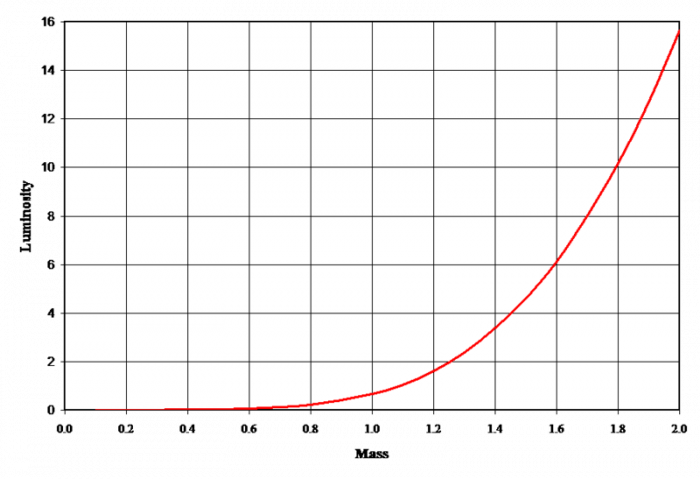As The Mass Of The Star Increases, How Do You Think Its Luminosity Might Change?
The Mass-Luminosity Relationship
![]() Impress
Impress
Additional reading from www.astronomynotes.com
- The Hertzsprung-Russell Diagram
- Stellar Evolution: Mass dependence
Earlier returning to open clusters and globular clusters, we are going to revisit the topic of stellar lifetimes, only this time in some more depth. Recall from Lesson 5 on pages 4 and 5 that we talked virtually how you might quickly estimate the time a star tin can remain on the Main Sequence and that O stars live substantially shorter lifetimes than K stars. We can actually derive a human relationship for the lifetime of a star using what we know already about stars.
From our study of binary stars, we are able to summate the mass of the stars in the binary organisation. If you know the altitude and the apparent effulgence of a star, you can besides summate its luminosity. And so, simply using observational data, we accept learned that stars forth the Main Sequence are a sequence in mass. O stars are the nearly massive, and then B stars, then A, F, G, K, and M stars are the least massive. Since the Main Sequence is also a sequence in luminosity—that is, O stars are the about luminous, then B, then A, F, G, K, and One thousand stars are the to the lowest degree luminous—there must be a relationship between mass and luminosity. If you plot the masses for stars on the ten-axis and their luminosities on the y-axis, you lot can calculate that the human relationship between these 2 quantities is:
This is normally referred to as the mass-luminosity relationship for Main Sequence stars. For a sample plot of this human relationship come across:
- astronomynotes.com
- The Australia Telescope Outreach and Education Web site
Given our theory for the structure of stars, you lot can empathize where this relationship comes from. Stars on the Chief Sequence must be using the energy generated via nuclear fusion in their cores to create hydrostatic equilibrium. The condition of hydrostatic equilibrium is that the pressure is balancing gravity. Since higher mass ways a larger gravitational strength, college mass must too mean that higher pressure is required to maintain equilibrium. If you lot increase the pressure inside a star, the temperature will as well increase. So, the cores of massive stars have significantly higher temperatures than the cores of Dominicus-like stars. At higher temperatures, the nuclear fusion reactions generate energy much faster, so the hotter the cadre, the more luminous the star.
If you actually look at the equations that govern stellar structure, yous can derive from those equations that:
where the exponent varies a bit for stars of different masses, but, in general, is approximately equal to 3.v, as is seen to be the case with the observed masses and luminosities for stars in binary systems.
Beneath is a plot that obeys this human relationship and gives the theoretical calculations of a star'due south luminosity given its initial mass on the Main Sequence.

Effigy vii.three: This ZAMS mass-luminosity table was generated using data from the isochrone adding tool of Lionel Siess. The metallicity (Z) is 0.02 and the axis units use solar values. Note that the present-day Sun is more luminous than when it start joined the main sequence. The luminosity strongly increases for stars with masses greater than about 1.three solar masses.
Now, let's revisit the topic of stellar lifetimes. The amount of fuel that a star has available for fusion is directly proportional to its mass. The luminosity measures how chop-chop the star is using that fuel, so, in general, a crude guess of the lifetime of a star is:
merely, yous can substitute in using and determine that:
Every bit we continue our study of star clusters, keep this in mind—the more massive a star, the faster information technology lives its lifetime, and, given the exponent of this human relationship, it isn't a linear relationship. That is, a x times more massive star doesn't live a lifetime 10 times shorter than the lower mass star, but approximately a 316 times shorter lifetime than the lower mass star!
Source: https://www.e-education.psu.edu/astro801/content/l7_p3.html
Posted by: davishatted.blogspot.com

0 Response to "As The Mass Of The Star Increases, How Do You Think Its Luminosity Might Change?"
Post a Comment